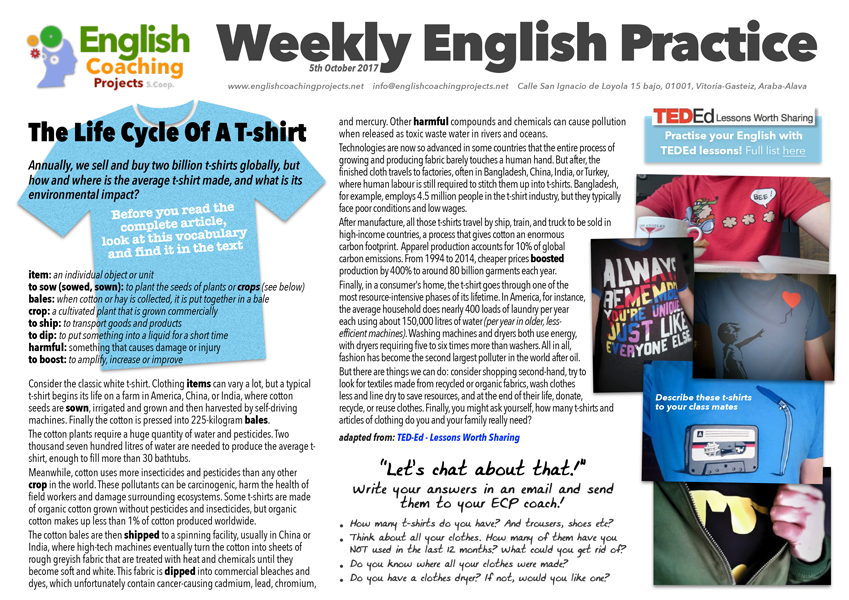Click on the image to download the pdf
Annually, we sell and buy two billion t-shirts globally, but how and where is the average t-shirt made, and what is its environmental impact?
Vocabulary
Read and check you understand this before you read and listen to the article:
item: an individual object or unit
to sow (sowed, sown): to plant the seeds of plants or crops (see below)
bales: when cotton or hay is collected, it is put together in a bale
crop: a cultivated plant that is grown commercially
to ship: to transport goods and products
to dip: to put something into a liquid for a short time
harmful: something that causes damage or injury
to boost: to amplify, increase or improve
Consider the classic white t-shirt. Clothing items can vary a lot, but a typical t-shirt begins its life on a farm in America, China, or India, where cotton seeds are sown, irrigated and grown and then harvested by self-driving machines. Finally the cotton is pressed into 225-kilogram bales.
The cotton plants require a huge quantity of water and pesticides. Two thousand seven hundred litres of water are needed to produce the average t-shirt, enough to fill more than 30 bathtubs.
Meanwhile, cotton uses more insecticides and pesticides than any other crop in the world. These pollutants can be carcinogenic, harm the health of field workers and damage surrounding ecosystems. Some t-shirts are made of organic cotton grown without pesticides and insecticides, but organic cotton makes up less than 1% of cotton produced worldwide.
The cotton bales are then shipped to a spinning facility, usually in China or India, where high-tech machines eventually turn the cotton into sheets of rough greyish fabric that are treated with heat and chemicals until they become soft and white. This fabric is dipped into commercial bleaches and dyes, which unfortunately contain cancer-causing cadmium, lead, chromium, and mercury. Other harmful compounds and chemicals can cause pollution when released as toxic waste water in rivers and oceans.
Technologies are now so advanced in some countries that the entire process of growing and producing fabric barely touches a human hand. But after, the finished cloth travels to factories, often in Bangladesh, China, India, or Turkey, where human labour is still required to stitch them up into t-shirts. Bangladesh, for example, employs 4.5 million people in the t-shirt industry, but they typically face poor conditions and low wages.
After manufacture, all those t-shirts travel by ship, train, and truck to be sold in high-income countries, a process that gives cotton an enormous carbon footprint. Apparel production accounts for 10% of global carbon emissions. From 1994 to 2014, cheaper prices boosted production by 400% to around 80 billion garments each year.
Finally, in a consumer’s home, the t-shirt goes through one of the most resource-intensive phases of its lifetime. In America, for instance, the average household does nearly 400 loads of laundry per year each using about 150,000 litres of water (per year in older, less-efficient machines). Washing machines and dryers both use energy, with dryers requiring five to six times more than washers. All in all, fashion has become the second largest polluter in the world after oil.
But there are things we can do: consider shopping second-hand, try to look for textiles made from recycled or organic fabrics, wash clothes less and line dry to save resources, and at the end of their life, donate, recycle, or reuse clothes. Finally, you might ask yourself, how many t-shirts and articles of clothing do you and your family really need?
“Let’s chat about that!”
Write your answers and send them by email to your ECP coach. Why not record your voice too? Listen to yourself speak and identify what you have to improve on ????
Give reasons for your answers.
- How many t-shirts do you have? And trousers, shoes etc?
- Think about all your clothes. How many of them have you NOT used in the last 12 months? What could you get rid of?
- Do you know where all your clothes were made?
- Do you have a clothes dryer? If not, would you like one?
adapted from: TED-Ed – Lessons Worth Sharing


